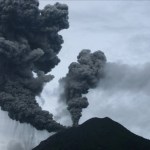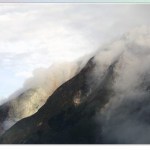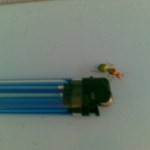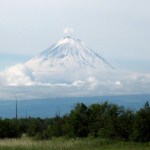indonesia
Classes starting today, so I have to be brief:
Unique twin ash plumes from Sinabung in Indonesia, erupting on August 29, 2010.
Sinabung
The Indonesian volcano continues to experience explosions, which one last night (well, last night here in Ohio) that prompted an ash advisory for aircraft up to 6,100 m / 20,000 feet, although most reports I've seen pegged the ash column at closer to 2,000 m / ~6,500 feet. Eruptions readers have found a bevy of links for footage and information about the eruption, including a remarkable image gallery from the BBC that shows the volcano exhibiting two ash…
Sinabung on Sumatra erupting on August 29, 2010.
Eruptions readers were quick on the news about the new eruption at Sinabung in Indonesia. There isn't much known about the eruptive history of the volcano - checking out the Global Volcanism Program, the last activity at Sinabung might have been an explosive event in 1881 with persistent fumaroles up until 1912. However, most news sources are quoting 400 years as the last known eruption of the volcano, apparently information from the Indonesian government.
The eruption itself appears to be an ash-rich explosion with ash fall reported up to 30…
Sorry about the lack of posts - I've been not only frantically prepping for class and my Eyja talk, but also I'm somewhat under the weather with an ill-timed sickness, so even though there is stuff to talk about, I haven't really had time/wherewithal to deal with it.
However, expect big things from Eruptions next week!
Drawing of a ship washed inland by the tsunami generated by the August 27, 1883 eruption of Krakatau.
I'll throw a few quick links:
The alert status at Galeras has been dropped back down to "orange" after the non-explosive eruption earlier this week. However, INGEOMINAS warns…
Karangetang in Indonesia erupting in June of 2007.
This year we haven't had a lot of news about volcanic activity in Indonesia. This is not to say that eruptions haven't been happening, rather they just haven't been in the news. If you check out the current status of the volcanoes of Indonesia, you'll see that no less than six volcanoes are on orange (Level 2) status and another fourteen are on yellow (Level 1 - and there is a Level 0 as well). So, it is a active arc as arcs go (compare that to the Aleutians or Cascades).
This means that it should come as little surprise that Karangetang on…
Tourists hiking next to an active lava flow on Pacaya in Guatemala in 2006.
I'm flying back to Ohio today after a successful few weeks of fieldwork/paper writing. Apparently I have a pile of tomatoes waiting in our garden in Granville ... !
On to news:
To go with the news that lava flows from Kilauea creep ever closer to structures in Kalapana, the NASA Earth Observatory posts its first volcano image in a bit. The shot shows the steam-and-gas plume from the Halema`uma`u Crater in Kilauea's summit caldera. You can also see some video of the lava flows near Kalapana as they move along the…
The latest news from the world of volcanoes, brought to us by the Global Volcanism Program, USGS and the Smithsonian Institution. They are also brought to us by Sally Kuhn Sennert - and if you have a question for her about her job at the GVP preparing the Weekly Volcanic Activity Report and all things volcanic (and hopefully it won't end like another recent volcanically-mitigated interview).
Some highlights (not including Gorely and Sakurajima):
Ioto (aka Iwojima) in the Volcano Islands of Japan produced an ash plume of unknown height. The volcano has frequent phreatic eruptions and abundant…
Looking for some volcano news - you've found it.
A shot of volcano "tourists" near the erupting Pacaya. Photo by the Associated Press.
Eruptions reader Dr. Boris Behncke dropped a note that Kilauea has not one but two active lava lakes right now. The lava lakes can be seen on the webcams for the Halema`uma`u Crater and the Pu`u O`o flank vent. The latest status update from June 6th by the USGS Hawaiian Volcano Observatory talks about both the summit and rift activity (video) on Kilauea as well. Meanwhile, Hawaii 24/7 has a piece in the Volcano Watch series about whether residents of Maui…
For all of you going into withdrawal now that Eyjafjallajökull seems to have quieted down, there are two eruptions of note that aren't in the North Atlantic:
Undated image of the Barujari cone at Mt. Rinjani in Indonesia.
Arenal in Costa Rica - which is almost always sputtering away - had a more significant explosive and effusive event today. The volcano produced enough ash, bombs and gas emissions - along with 8 lava flows (or avalanches, depending on the source) - to prompt the evacuation of the National Park around the volcano. Arenal has had numerous strombolian eruptions over the last…
Hard to believe, but there is other volcano-related news in the world ...
So, with all deference to Eyjafjallajokull, here it is:
Dome collapse on Colima in Mexico, image taken March 30, 2010.
The new Smithsonian/USGS GVP Weekly Volcano Activity Report was issued, with news about increasing signs of activity at Egon in Indonesia, a possible plume at Miyakejima in Japan and more dome growth at Soufriere Hills.
A study on the economic effect of a new Vesuvius eruption was released and the finding show the potential for a staggering $24 billion of economic damage directly related to an…
News!
Toba caldera in Indonesia.
We're all still talking about the Chilean earthquake and the coverage of the event. If you happen to live in the Columbus area, you might have heard me on WTVN talking about the earthquake as well.
The Toba (Indonesia) eruption 74,000 years ago has been used by some researchers to be the cause of a "genetic bottleneck" for humans - however, that is still much debated. Currently, excavations are under away near Toba to look for evidence of human habitation that was buried by the eruption. The evidence of stone tools that appear to be made by the same human…
The flu has retreated and I'm getting back on track. Huzzah!
I'll get back to the blog by posting this week's new USGS / Smithsonian Institution Global Volcanism Program Weekly Volcano Report. Looks like some interesting stuff in it ...
Looks like there were some small eruptions from Oldoinyo Lengai in Tanzania. The volcano is one of the few (only active?) carbonatite volcanoes in the world, erupting a lava composed primarily of calcium carbonate and sodium minerals with very little silica. It leads to the odd lava that erupt black (and cool ~ 500C) and cool to white, making it one of the…
An Indonesian Zooillogix reader, Harianto Talim, grossly overestimated our entomological abilities and asked us to help him identify an Indonesian ant that he has never seen before. In this blurry series of photos, you can see that the ant is bright orange and green and may or may not smoke cigarettes. It should be noted however that when confronted about the lighter in the ant's pocket by its mother, the queen, the ant claimed it just carries the lighter around to light other ants' cigarettes to look cool.
So nerdy readers, time to prove your mettle by identifying this random blurry ant!…
Back to work after Thanksgiving Break ... lets clean up a few news items I missed trying to figure out the non-eruption of Karkar.
Undated photo of the summit area of Gaua, Vanuatu.
There was an actual eruption - or, more correctly, a continued eruption - of Gaua in Vanuatu. The current activity has prompted the evacuation of 300 villagers from the island and they will not be able to return until activity wanes. Tourists were also told to stay away from the volcano, but the airport on the island has not been affected by the eruption, which might suggest the activity is relatively localized…
The latest of volcano news from around the world, brought to you by the USGS and Smithsonian Institute Global Volcanism Program (and especially Sally Kuhn Sennert!)
Highlights this week include:
Karangetang in Indonesia produced a couple 3 km/10,000 foot steam-and-ash plumes according to reports from pilots.
Soufriere Hills on the island on Montserrat has had quite a few pyroclastic flows over the last few weeks since the volcano started erupting again. Mix that with some heavy rainfall and lahars were produced as well.
The alert level is still at Orange at Karymsky in Kamchatka, which…
I finally remembered to bring my GSA notes with me to the office, so I can finally post a wrap up of what I saw/heard at the big 2009 meeting in Portland. I'll have a specific post on Kasatochi - too much to say here. However, a great time was had by all!
The crater of Collier Cone in Oregon. The scoria cone likely experienced years of explosive strombolian eruptions when it formed.
Some interesting volcano-related notes:
Clive Oppenheimer pointed out that the Toba eruption 74,000 years ago covered >1% of the Earth's surface with >10 cm (~4 in) ash. To put that in perspective, the…
To the updates!
Batu Tara volcano in Indonesia. The volcano is currently producing small ash plumes.
I was distracted enough by trying to figure out a way to teach about Miller Indices that I plum forgot to post this week's USGS/SI Weekly Volcanic Activity Report. It was a fairly quiet week so you didn't miss much. Enjoy it at your leisure.
Rabaul must be positioned on the globe in such a way that NASA's Aqua satellite always gets a good shot at it. The Earth Observatory posted a new image of the plume from Rabaul and it looks thicker and more ash-laden than the image posted a few weeks ago…
tags: South Pacific Islands, Indonesia, Sumatra, geology, nature, volcano, global warming, Lake Toba, PBS, NOVA, television
Sixty-two-mile-long Lake Toba, seen in the center of this satellite image,
was created by the largest explosive volcanic eruption of the past
100,000 years -- an eruption whose aftermath holds important clues for us
today about rapid climate change, Drew Shindell says.
Image: NASA.
Wow, there are days when I wish I had a television, and today is one of them. Why? Tonight, PBS is showing a really fascinating program; a NOVA show entitled Mystery of the Megavolcano that…
Busy today with scouting out some field location for the class I'll be teaching this fall. Here's this week's USGS/SI Weekly Volcano Report. The report is a little more eventful than last week's, so enjoy!
Kliuchevskoi Volcano in Kamchatka, taken summer of 2009 by Theresa Kayzar.
Highlights include:
Three volcanoes on the Kamchatka Peninsula are currently producing ash plumes: Kliuchevskoi, Koryaksky and Shiveluch. Shiveluch has been having the most intense eruptions, but the former two are both producing ash-and-steam plumes that reach over 3 km / 10,000 feet.
Talang in Indonesia saws its…
Even the SI/USGS Weekly Volcano Report seems a little light -- welcome to the dog days of summer!
Highlights from this week's report include:
"Thunderous sounds", incandescence and small plumes (hundreds of meters) with more frequent seismicity at Ibu in Indonesia.
A sharp increase in sulfur dioxide output was noted at Mayon in the Philippines on August 4 - from ~700-900 tonnes/day to almost 2,000 tonnes/day.
~3,000 meter/10,000 foot gas-and-ash plume from Bagana in Papua New Guinea - you can see it on this recent NASA Earth Observatory image.
Ash/gas plumes from Sakurajima in Japan rose to…
Some more volcano news for the day ...
UPDATE 10:40AM Eastern: It has been pointed out to me that both of these articles are old. They apparently made it into my Google News feed thanks to a glitch in the magic interweb tubes somewhere. Just goes to show that blogging before coffee on a Monday after traveling across the country = bad idea. Sorry for any confusion.
A summit dome at Kelud during the 2007 eruption.
OLD NEWS ABOUT SARYCHEV PEAK IN JUNE 2009. An unnamed Russian volcano in Kamchatka is disrupting flights from Canada to Asia. No ID in the article on which volcano, and I couldn't…



